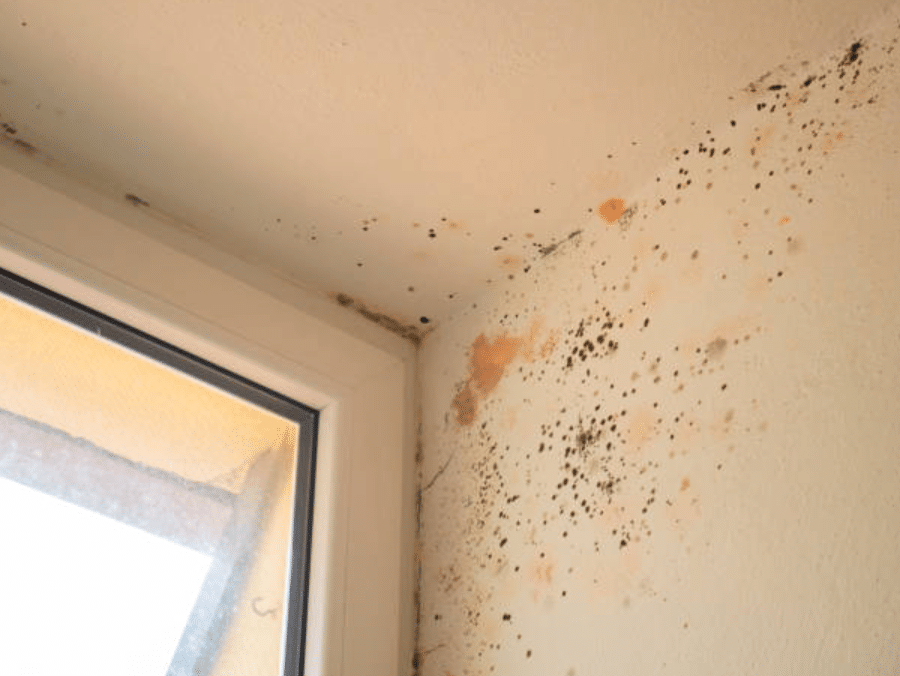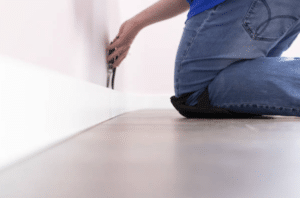Have you ever seen a red mould growing in your bathroom or kitchen? If so, you’re not alone. Red mould is a common type of mould that can grow in damp, humid environments.
While it’s not always harmful, it’s important to know how to identify and get rid of red mould if you see it in your home.
In this article, I’ll cover everything you need to know about red mould. Having had my own encounters with red mould in my home, and I know how frustrating and scary it can be.
That’s why I’m committed to helping others learn about red mould and how to protect themselves from its harmful effects.
So, whether you’re a homeowner, renter, or landlord, read on and learn everything you need to know about red mould. By the end of this guide, you’ll be able to identify red mould, understand its risks, and take steps to get rid of it and prevent it from coming back.
Key Takeaways:
- Red mould, also known as red mould, thrives in damp and humid environments.
- It can grow on various surfaces, including walls, ceilings, and food.
- Exposure to red mould can cause respiratory symptoms and allergic reactions.
- Preventing red mould growth requires proper ventilation and humidity control.
- Cleaning and vacuuming regularly can minimise exposure to dust mites, which contribute to mould growth.
Statistics and data on red mould in the UK
According to a 2020 study by the University of Exeter, red mould is one of the most common types of mould found in UK homes.
The study also found that red mould is more likely to be found in homes with damp and humid conditions.
A 2021 study by the Asthma and Allergy Foundation found that exposure to red mould can trigger asthma attacks in people with the condition. The study also found that exposure to red mould can increase the risk of developing asthma in children.
What is Red Mould – Can You Avoid It
Red mould, also known as red mould, is a type of mould that can be found in damp and humid environments.
It is characterised by its red or pinkish colour and can grow on various surfaces, including walls, ceilings, and even food.
Red mould can be harmful to health, as it can produce allergens and toxins that can cause respiratory symptoms, such as sneezing, wheezing, and breathlessness.
To prevent red mould growth, it is important to keep indoor spaces well-ventilated and control humidity levels.
Regular cleaning and vacuuming can also minimise exposure to dust mites, which can contribute to mould growth.
It is important to follow a treatment plan prescribed by a doctor if red mould exposure leads to respiratory symptoms.
Inhalation therapy, which involves the use of inhalers, can help control symptoms and prevent flare-ups.
Identifying Red Mould: Types and Symptoms
Red mould comes in different types, varying in appearance and growth patterns, but they all share the common characteristic of a red or pinkish colour.
It can appear as a powdery substance or as a slimy film, and it typically thrives in damp and humid environments.
Some common types of red mould include Stachybotrys chartarum, Fusarium, and Aspergillus.
Each type has its own unique growth patterns and may present different symptoms when inhaled or touched.
When it comes to symptoms, red mould exposure can lead to a range of respiratory issues. Common symptoms include sneezing, coughing, wheezing, shortness of breath, and a runny or stuffy nose.
In some cases, individuals may also experience skin irritation or allergies, such as redness, itching, or rashes upon contact with the mould.
It is important to note that the severity of symptoms can vary depending on the individual’s sensitivity to allergens and the extent of exposure to the mould.
To further understand the connection between red mould and allergies, it is crucial to recognise the potential health risks associated with exposure.
Inhalation of red mould spores can trigger respiratory allergies in sensitive individuals, leading to inflammation in the airways and resulting in symptoms similar to asthma.
Additionally, red mould can produce mycotoxins, which are toxic substances that can cause a range of health problems, including respiratory issues, flu-like symptoms, and even neurological effects in severe cases.
| Type of Red Mould | Appearance | Growth Patterns |
|---|---|---|
| Stachybotrys chartarum | Blackish-green slimy film | Commonly found in water-damaged buildings, particularly on materials with high cellulose content, such as drywall or ceiling tiles |
| Fusarium | Pinkish or reddish cotton-like texture | Thrives in high humidity environments, often found on water-damaged carpets, wallpaper, or fabrics |
| Aspergillus | Reddish or brownish fuzzy appearance | Commonly found in damp environments, such as bathrooms or kitchens, and can grow on various surfaces, including walls, ceilings, and food |
If you suspect red mould growth in your home or experience any symptoms associated with mould exposure, it is important to seek professional advice and consider contacting a mould removal specialist.
They can assess the situation, identify the type of mould present, and provide effective solutions for eradication and prevention.
Remember, dealing with red mould requires proper expertise and equipment to ensure safe and thorough removal.
Health Risks of Red Mould Exposure
Exposure to red mould can pose significant health risks, particularly for those with respiratory conditions or weakened immune systems.
Red mould, also known as red mould, is a type of mould that thrives in damp and humid environments.
Its distinctive red or pinkish colour makes it easily identifiable on various surfaces, including walls, ceilings, and even food.
One of the main concerns with red mould is its ability to produce allergens and toxins. When these substances are inhaled or come into contact with the skin, they can cause a range of respiratory symptoms, such as sneezing, coughing, wheezing, and breathlessness.
In some cases, individuals may also experience allergic reactions, including skin rashes and itching.
To minimise the health risks associated with red mould exposure, it is crucial to address the underlying moisture problem in your home.
Red mould thrives in damp environments, so proper ventilation and humidity control are essential. Regular cleaning and vacuuming can also help reduce the presence of dust mites, which can contribute to mould growth.
If you suspect that red mould is present in your home and are experiencing respiratory symptoms, it is crucial to seek medical advice.
A doctor may prescribe inhalation therapy or other treatments to help manage symptoms and prevent further complications.
Health Risks of Red Mould Exposure
- Respiratory symptoms
- Allergic reactions
- Sneezing
- Coughing
- Wheezing
- Shortness of breath
- Skin rashes
- Itching
Red mould exposure can have detrimental effects on your health, particularly if you have respiratory conditions or a weakened immune system.
It is crucial to address any moisture issues in your home and seek professional assistance if you suspect red mould growth.
By taking proactive measures and following medical advice, you can minimise the health risks associated with red mould and create a safer environment for you and your family.
Preventing Red Mould Growth
Taking proactive measures to prevent red mould growth is crucial for maintaining a healthy and mould-free living environment.
Red mould thrives in damp and humid conditions, so it’s important to address any moisture issues in your home. Here are some effective strategies to prevent red mould growth:
Ensure proper ventilation: Proper airflow is essential in preventing excess moisture buildup. Use exhaust fans in bathrooms and kitchens, open windows regularly to allow fresh air in, and consider installing a dehumidifier in areas prone to high humidity.
Control indoor humidity: Maintain indoor humidity levels between 30% and 50%. Use a hygrometer to monitor humidity levels and use air conditioners or dehumidifiers to reduce moisture when necessary.
Fix leaks promptly: Any leaks in plumbing, roofs, or windows should be repaired promptly to prevent water damage and create a favourable environment for mould growth.
Keep surfaces clean and dry: Regularly clean and dry surfaces prone to moisture, such as bathrooms, kitchens, and basements. Use mildew-resistant paint or sealant in areas susceptible to moisture.
Reduce clutter: Cluttered areas can impede proper airflow and create pockets of humidity. Keep your living spaces tidy and organised to minimise the risk of mould growth.
By following these preventative measures, you can significantly reduce the likelihood of red mould growth in your home.
Remember that prevention is key when it comes to maintaining a healthy and mould-free environment.
Table: Common Sources of Moisture in Homes
| Source of Moisture | Prevention Tips |
|---|---|
| Excessive humidity | Use dehumidifiers and air conditioners, ensure proper ventilation |
| Leaking pipes or faucets | Promptly repair any leaks, inspect plumbing regularly |
| Poorly insulated windows or doors | Improve insulation, apply weatherstripping |
| Roof leaks | Regularly inspect and maintain your roof, repair any damage promptly |
“Prevention is key when it comes to maintaining a healthy and mould-free environment.”
By adopting these preventative measures and being vigilant about moisture control, you can create an environment that is inhospitable to red mould growth.
Remember, early prevention is always easier than dealing with a full-blown mould problem, so take proactive steps to safeguard your home and your health.
Hazards of Red Mould in Your Home
Red mould growth in your home can not only cause structural damage but also pose serious health risks to you and your family.
Red mould, also known as red mould, is a type of mould that thrives in damp and humid environments, making your home an ideal breeding ground.
This type of mould is characterised by its distinct red or pinkish colour and can be found on various surfaces, including walls, ceilings, and even food.
Exposure to red mould can have detrimental effects on your health. The mould produces allergens and toxins that can trigger respiratory symptoms such as sneezing, wheezing, and breathlessness.
For individuals with pre-existing respiratory conditions like asthma or allergies, exposure to red mould can exacerbate symptoms and lead to severe health complications.
It is crucial to address red mould growth promptly to minimise the risks to your well-being and that of your family.
To prevent the growth of red mould in your home, it is essential to maintain proper ventilation and control indoor humidity levels.
Ensure that rooms are adequately ventilated, especially in high-moisture areas such as bathrooms and kitchens. Use dehumidifiers or open windows to reduce humidity and promote air circulation.
Regular cleaning and vacuuming can also help minimise dust mites, which can contribute to mould growth. Taking these preventive measures can significantly reduce the likelihood of red mould taking hold in your home.
Signs of Red Mould in Your Home
- Visible clusters or patches of red or pinkish mould on walls, ceilings, or other surfaces
- A musty or earthy odor in specific areas, indicating mould growth
- Increased respiratory symptoms, such as coughing, sneezing, and difficulty breathing
- Water leaks or high humidity levels that promote mould growth
- Worsening of existing respiratory conditions, such as asthma or allergies
If you suspect or identify red mould in your home, it is crucial to seek professional mould removal services for safe and effective treatment.
Attempting to clean or remove the mould yourself can be dangerous, as it can release spores into the air, increasing the risk of inhalation and further contamination.
Professional mould removal experts have the necessary expertise and equipment to identify and eliminate red mould safely, providing you with peace of mind and ensuring the health of your home environment.
Safely Eliminating Red Mould from Your Home
If you are dealing with red mould in your home, it is crucial to follow proper protocols to ensure its safe and complete removal.
Red mould can pose serious health risks, so taking the necessary precautions is essential. Here are some steps you can take to safely eliminate red mould from your home:
Identify the Source
The first step in removing red mould is to identify the source of the problem. Inspect your home thoroughly to find any areas that are damp or have a high humidity level.
Common areas where red mould can thrive include bathrooms, basements, and kitchens. Once you have identified the source, take measures to address the underlying moisture issue to prevent further mould growth.
Wear Protective Gear
Before starting the removal process, it is important to protect yourself from exposure to mould spores. Wear gloves, goggles, and a mask to prevent inhalation or skin contact with the mould. This will help minimise the risk of adverse health effects.
Remove Affected Materials
If the red mould has contaminated porous materials such as drywall or carpet, it may be necessary to remove and replace them.
These materials can provide a breeding ground for mould and may be difficult to fully clean and disinfect. It is best to consult with a professional mould removal service to ensure proper removal and disposal of contaminated materials.
Clean and Disinfect
For non-porous surfaces such as tiles or countertops, you can clean and disinfect them using a solution of water and mild detergent.
Scrub the affected area thoroughly to remove all visible signs of mould. After cleaning, use a disinfectant to kill any remaining spores. Ensure that the area is completely dry to prevent future mould growth.
Monitor and Prevent
Once you have successfully removed the red mould from your home, it is important to monitor the area regularly to ensure that it does not return.
Keep your home well-ventilated and control humidity levels to discourage mould growth. Regularly clean and vacuum to minimise dust mites, which can contribute to mould growth.
If you notice any recurring signs of mould, seek professional assistance to address the issue promptly.
Dealing with red mould in your home requires following proper protocols to ensure its safe and complete removal.
Start by identifying the source of the problem, addressing any moisture issues, and wearing protective gear.
Remove and replace any contaminated materials and thoroughly clean and disinfect non-porous surfaces.
Monitor the area and take preventive measures to discourage mould growth. Following these steps will help you effectively eliminate red mould and safeguard your home and health.
Red Mould and Allergies: Understanding the Link
For individuals with allergies, exposure to red mould can lead to uncomfortable and potentially severe symptoms.
Red mould, also known as red mould, is a type of mould that thrives in damp and humid environments, making it a common problem in homes and buildings with moisture issues.
When red mould spores are released into the air, they can be inhaled and trigger allergic reactions in sensitive individuals.
Common symptoms of red mould allergies include sneezing, coughing, itchy or watery eyes, nasal congestion, and skin irritation.
In more severe cases, exposure to red mould can also cause respiratory symptoms such as wheezing, shortness of breath, and chest tightness.
These symptoms can be particularly problematic for individuals with asthma or other respiratory conditions.
To minimise the risk of red mould allergies, it is important to address any moisture issues in your home.
Ensure that areas prone to dampness, such as bathrooms, kitchens, and basements, are well-ventilated and kept dry.
Use dehumidifiers and exhaust fans to reduce humidity levels and prevent mould growth. Regularly clean and vacuum your living spaces to remove dust and allergens that can contribute to mould growth.
If you suspect red mould in your home, it is advisable to seek professional mould removal services to ensure safe and effective elimination.
| Symptoms of Red Mould Allergies: | Prevention and Management: |
|---|---|
| Sneezing | Address moisture issues in your home |
| Coughing | Keep areas prone to dampness well-ventilated |
| Itchy or watery eyes | Use dehumidifiers and exhaust fans |
| Nasal congestion | Clean and vacuum your living spaces regularly |
| Skin irritation | Seek professional mould removal services if needed |
Remember, prevention is key when it comes to red mould allergies. By taking proactive measures to control moisture and maintain a clean indoor environment, you can reduce the risk of exposure and protect yourself and your family from the discomfort of red mould allergies.
Importance of Professional Mould Removal Services
When faced with red mould growth, it is crucial to seek the assistance of experienced mould removal specialists who possess the necessary skills and knowledge.
Red mould, also known as red mould, can be a serious health hazard if not properly addressed. It can spread quickly and release harmful allergens and toxins into the air, causing respiratory symptoms and exacerbating existing allergies or asthma.
Professional mould removal experts have the expertise to identify the type of red mould present and assess the extent of the infestation.
They possess the necessary tools and equipment to safely and effectively remove the mould, minimising the risk of further contamination.
With their knowledge of proper containment and disposal techniques, they can prevent the spread of mould spores to unaffected areas of your home.
Furthermore, mould removal specialists can provide valuable advice on preventing future mould growth.
They can identify the underlying causes of mould growth, such as moisture issues or poor ventilation, and recommend appropriate solutions.
By addressing these underlying issues, you can reduce the likelihood of mould returning and ensure a healthier living environment for you and your family.
Don’t underestimate the dangers of attempting to clean red mould yourself. DIY methods may only provide temporary relief or even worsen the situation.
Without the proper knowledge and equipment, you run the risk of ineffective removal, spreading mould spores throughout your home, and potentially exposing yourself to harmful substances.
In conclusion, when facing red mould growth in your home, it is vital to rely on the expertise of mould removal specialists.
Protect your health and the well-being of your loved ones by entrusting the task to professionals who understand the intricacies of mould removal and can provide a safe and effective solution.
Conclusion
Red mould can be a serious health hazard, but with the help of mould experts like AirFresh Mould Removal London, you can ensure a mould-free and healthy living environment.
Red mould, also known as red mould, is a type of mould that thrives in damp and humid environments.
It manifests as a red or pinkish colur and can grow on various surfaces, including walls, ceilings, and even food.
This type of mould poses health risks as it can produce allergens and toxins that can trigger respiratory symptoms such as sneezing, wheezing, and breathlessness.
To prevent red mould growth in your home, it is crucial to maintain proper ventilation and control humidity levels.
Regular cleaning and vacuuming can minimise exposure to dust mites, which contribute to mould growth.
However, if red mould is already present, it is important to seek professional mould removal services to effectively eliminate the mould and prevent further spread.
AirFresh Mould Removal London is a trusted and reliable mould cleaning service in the London area. Their team of mould specialists has the expertise and equipment needed to safely and effectively remove red mould from your home.
Attempting to clean red mould yourself can be hazardous, as it may result in health risks and further spread of the mould. It is best to rely on professionals who follow the recommended treatment protocols for safe and thorough mould removal.
If exposure to red mould leads to respiratory symptoms, it is crucial to consult a doctor and follow a prescribed treatment plan. Inhalation therapy, which involves the use of inhalers, can help control symptoms and prevent flare-ups.
By addressing red mould issues promptly and effectively, you can create a mould-free and healthy living environment for you and your family.
Introducing AirFresh Mould Removal London
For professional and efficient mould removal services in London, look no further than AirFresh Mould Removal London.
With their team of experienced mould specialists, they are dedicated to providing top-quality services to help you eliminate red mould from your home and ensure a safe and healthy living environment.
At AirFresh Mould Removal London, they understand the importance of addressing mould problems promptly and effectively.
Their experts are trained to identify the type of red mould present and implement the appropriate treatment methods to completely eradicate it.
They utilise advanced equipment and techniques that are designed to safely remove the mould without causing further contamination or damage to your property.
Whether you are dealing with red mould growth on walls, ceilings, or any other surface, AirFresh Mould Removal London has the expertise to handle it.
They follow strict protocols to ensure that the mould is removed in a thorough and efficient manner, leaving your home mould-free and fresh.
Don’t let red mould compromise the health and safety of your home. Contact AirFresh Mould Removal London today for reliable and professional mould cleaning services in London.
Their team is ready to assist you with all your mould removal needs, providing peace of mind and a healthier living environment for you and your family.
| Why Choose AirFresh Mould Removal London? | Services Offered |
|---|---|
|
|
Dangers of DIY Mould Cleaning
Cleaning red mould by yourself can be dangerous and counterproductive, as it can potentially worsen the situation and put your health at risk.
Red mould, also known as red mould, is a type of mould that thrives in damp and humid environments. Its red or pinkish appearance makes it easily identifiable, but dealing with it requires caution and expertise.
“Removing red mould without professional help can be risky. Incorrect cleaning methods can release spores into the air, increasing the risk of inhalation and further contamination,”
Red mould can release allergens and toxins that can trigger respiratory symptoms and allergies, causing sneezing, coughing, and even more severe breathing difficulties.
Without the proper knowledge and equipment, attempting to clean red mould yourself can lead to inadequate removal, leaving behind hidden spores that can continue to spread and pose health risks.
Seeking the assistance of mould experts is essential to ensure effective and safe elimination of red mould.
Professional mould cleaning services, such as AirFresh Mould Removal, have the knowledge, experience, and specialised equipment to handle mould infestations properly and prevent further contamination.
They can assess the extent of the problem, identify the source of moisture causing the mould growth, and employ appropriate cleaning techniques to eliminate the mould completely.
Benefits of Professional Mould Cleaning Services
- Thorough inspection and assessment
- Effective and safe mould removal
- Prevention of further contamination
- Expertise in identifying moulds
- Addresses underlying causes of mould growth
- Peace of mind, knowing the job is done right
Don’t risk your health and the effectiveness of mould removal by attempting a DIY approach. Instead, rely on the expertise of mould specialists who can provide professional mould cleaning services tailored to your specific needs. Remember, when it comes to tackling red mould, it’s always better to be safe than sorry.
FAQ
Q:What is red mould?
A: Red mould is a type of mould that can be found in damp and humid environments. It is characterised by its red or pinkish colour and can grow on various surfaces, including walls, ceilings, and even food.
Q:Is red mould harmful to health?
A: Yes, red mould can be harmful to health. It can produce allergens and toxins that can cause respiratory symptoms, such as sneezing, wheezing, and breathlessness.
Q:How can I prevent red mould growth?
A: To prevent red mould growth, it is important to keep indoor spaces well-ventilated and control humidity levels. Regular cleaning and vacuuming can also minimise exposure to dust mites, which can contribute to mould growth.
Q:What should I do if I experience respiratory symptoms due to red mould exposure?
A:If you experience respiratory symptoms due to red mould exposure, it is important to follow a treatment plan prescribed by a doctor. Inhalation therapy, which involves the use of inhalers, can help control symptoms and prevent flare-ups.
Q:Can red mould grow in my home?
A:Yes, red mould can grow in homes, especially in areas with high humidity or dampness. Proper ventilation and humidity control can help prevent its growth.
It’s important to note that red mould can be difficult to remove, and it is never recommended to attempt to remove it yourself. If you find red mould in your home, you should contact a professional mould remediation company immediately.
Our team of experienced mould remediation professionals can safely and effectively remove red mould from your home, and we will work with you to prevent it from coming back.
Call us today at 0203 130 4068 for a free consultation.






